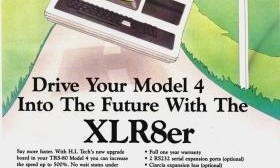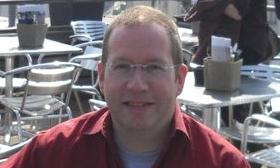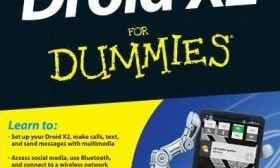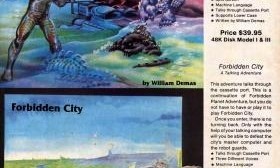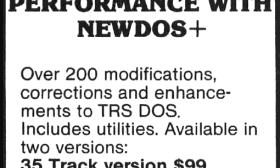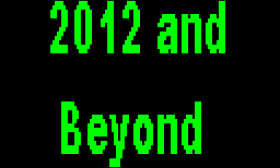The XLR8er (pronounced accelerator) was a speed-up and memory expansion board for the TRS-80 Model 4, regarded by many to be the ultimate Model 4 expansion. The XLR8er replaced the Model 4 Z80 CPU with an enhanced microprocessor that offered 256K of additional memory (for a total of 384K) and up to double the speed. The XLR8er originally sold for $299.95 (with memory) when H.I. Tech, Inc. introduced it around 1986, but that price soon dropped to $249.95.
The XLR8er hardware was based on the SB-180 single-board computer project that was presented by Steve Ciarcia in the September and October issues of BYTE and sold by MicroMint. The XLR8er was close enough to the SB-180 design that it was able to accept “Ciarcia” expansion modules designed for the SB-180.
(Read more...)
One of the most famous TRS-80 companies was Alpha Products. If you called technical support at Alpha Products after 1984, you probably spoke to Kevin Tschudi. While working there from 1981 to 1991, he wrote the VS-100 Talker software and Newclock-80 drivers and co-designed the A-Bus system.
In this interview, conducted in August 2011, he talks about his experiences at Alpha Products.
(Read more...)
Dan Gookin is a popular computer book author who has written 120 titles that have sold 12 million copies and been translated into over 30 languages. He is perhaps most famous for DOS for Dummies, his 1991 book which became the fastest selling computer book and launched the For Dummies series that continues today. He also maintains the web site Wambooli
In this interview, conducted in August 2011, he talks about how he started in computers with a TRS-80 Model III.
(Read more...)
William Demas is the author of many notable TRS-80 games, including
Panik,
Frogs,
Forbidden Planet, and
Forbidden City. In this interview, conducted in July 2011, he discusses his TRS-80 games and experiences.
(Read more...)
NEWDOS 2.1, also known as NEWDOS, NEWDOS/21, and NEWDOS+, was the first alternative disk operating system for the TRS-80 Model I. Introduced in March 1979 by Apparat, Inc. of Denver, Colorado, NEWDOS jump started the entire third-party TRS-80 disk operating system market. NEWDOS was considered by many to be an essential program for the Model I; it is quite possible that NEWDOS was more widely used than Model I TRSDOS itself.
(Read more...)
I used TRSTools to apply my 2012 date extension patches because I wanted to make the update process as easy as possible for people using an emulated TRS-80 with virtual disks. But for those of us with a “real” physical TRS-80, or who just want to update their disks the old-fashioned way, here are the free patch files for my 2012 date extension update.
There are three different sets of patches for three different operating systems: Model 4 LS-DOS 6.3.1, Model III LDOS 5.3.1, and Model I LDOS 5.3.1. Each set consists of an installer JCL file and six patch files.
(Read more...)
To extend LDOS and LS-DOS file dating past 2011, I decided to use an approach that I devised back in 1993 when I was first writing PERUSE, my TRS-80 file utility. My method stores the new date in the same fields in the directory without taking up any more space or taking away any more file passwords. This approach is automatically compatible with all LDOS/LS-DOS disks and I have yet to encounter a file for which this dating scheme fails. (If you do, please let me know so that I can fix the problem.) With my patches, disks don’t even need to be converted but will just transparently store dates after 2011.
My patches also fix a problem occasionally encountered with LDOS 5.3 and LS-DOS 6.3. If an older operating system was used to copy files onto a date converted disk, then the copied files will still have the older user password field. LDOS 5.3 and LS-DOS 6.3 (which replaced the user password with date and time) will interpret that password as a garbled date and time. The patches check specifically for such files and use the older year instead (providing more accurate results than unpatched versions).
(Read more...)
The reason dates past 2011 aren’t allowed in LDOS and LS-DOS relates to the way the year is stored in the TRS-80 disk directory. All major TRS-80 operating systems used roughly the same format for the directory. That format was derived from both the original Model I TRSDOS and VTOS 4.0 (both written by Randy Cook).
In the original date format (VTOS 4.0 and later), the date was stored in bytes 1 and 2 of a directory entry. Specifically, the file year was stored in three bits of byte 2. The maximum value that can be stored in three bits is 7, so the original allowed date range was between 1980 and 1987.
In 1987, LS-DOS 6.3 and LDOS 5.3 were released by Logical Systems and MISOSYS to address the year limit. Extra space was needed in the directory to extend the dating, which both operating systems achieved by removing the access (also known as user) password. This new dating format became known as “extended dating” or “date converted.”
(Read more...)
Nothing makes an operating system feel more antiquated than having an expiration date. For TRS-80 users, that expiration date is just around the corner. Model 4 LS-DOS and Model I and III LDOS will stop accepting the date in 2012 and the only solution is to disable the system date or lie about the year.
I happen to believe that LDOS and LS-DOS still have life left in them, so I have developed a set of patches to extend date handling to 2079. The result is a 100 year dating window, beginning January 1, 1980 and ending December 31, 2079.
The patches are free and there are six patches in the set:
(Read more...)
I was saddened to learn that Rick Hanson, long time TRS-80 Model 100 evangelist and enthusiast, died on April 30, 2011. He was the founder of Club 100, a very important Model 100 user group that began in 1983 and still exists today at club100.org.
Through Club 100, Rick Hanson repaired Model 100’s and provided them to people and groups that needed them, including newspapers and relief organizations. He also sold Model 100 peripherals and became the sole source of many items as the market contracted. He played a vital role in promoting new Model 100 hardware such as the NADSBox, a memory card storage device designed by Ken Pettit, and the REX, a ROM/RAM add-on designed by Stephen Adolph. He also ran the Club 100 BBS until October 2007.
Rick Hanson enjoyed promoting the Model 100, and was featured many times in newspaper articles. He also made a memorable August 2001 appearance on Leo Laporte’s television show on the TechTV channel where he demonstrated the durability of a Model 100 by dropping it to the ground without damage. He also later appeared on Laporte’s radio show in March 2008.
He was one of the friendliest people around in the computer world and he will be greatly missed.
